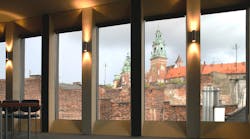Latest from Eatherton
Sponsored
This is a continuation of a series of articles on the benefits of applying electrically heated Thermal Dynamic Windows, also known as Radiant Windows.
In the previous articles, we were looking at the potential applications of applying the radiant windows in settings where condensation production on the cooler glass surfaces as a possibility. One area that we didn’t look at was the application in natatoriums or indoor swimming pools.
Historically speaking, natatoriums have been an energy intensive space to maintain. Prior to the introduction of DOAS (Dedicated Outdoor Air Systems) to wring out any incoming moisture, and to avoid the internal evaporation of pool water, the buildings maintain a constant makeup air, dehumidify within the space, and maintain a space air temperature that is at least 2°F to 3°F warmer than the swimming pool water temperature. Doing this 24 hours per day is an energy intensive operation.
The Red Cross recommends maintaining a swimming pool temperature of 78°F (competitive use) to 82°F (recreational use). In order to avoid compounded migration of evaporative moisture, this means having to maintain the space air temperature of between 80°F and 85°F, and humidity levels of 50-60 percent. In addition to these thermal and latent loads, the HVAC equipment may be required to remove or add energy depending upon the occupant loads and outside air conditions.
The air-based conditioning systems typically distribute this ducted airflow against the windows and exterior walls to avoid the possible production of condensation on these potentially cooler surfaces. This represents a fairly significant parasitic energy factor for moving all of this air around. As it pertains to the glazing systems, the dew point of the glass is generally such that it is necessary to wash the windows with heated air in order to keep those surfaces above the dew point and avoid the production of condensation, which can cause building structure degradation, as well as possibly supporting bacterial growth within the framing system.
My first reaction to being introduced to this product was that it is the greatest tool I have ever seen as it pertains to providing excellent human comfort in areas with significant glazing.
By incorporating thermally dynamic heated glass into the picture, the parasitic energy and the thermal energy demands of the building can be significantly reduced, as well as the initial expenses associated with the ducting system, air handler sizing and blower energy consumption. In addition to avoiding the energy expense of keeping the glass warm, the radiant windows will also raise the Mean Radiant Temperature within the space, thereby creating a more comfortable environment for the occupants within these spaces with a lower air temperature. It is much easier to maintain the internal glass temperature above the dew point with thermally dynamic glass, and avoid excess energy use associated with a strictly air based system in the process.
The Europeans have known this for quite some time, and have been incorporating these thermally dynamic heated glass windows into their natatoriums for many years. Of course, their cost of energy is four to five times as much as our energy costs per therm, so they’ve had some good economic incentives going for them for much longer than we North Americans have had.
This is but one benefit of this relatively new, to our market, product. As I have noted in previous articles, my first reaction to being introduced to this product was that it is the greatest tool I have ever seen as it pertains to providing excellent human comfort in areas with significant glazing. And I still believe in that premise. I also believe, as industry icon Robert Bean has been promoting for many years, that if we design our structures around human comfort, that energy conservation will follow. I strongly believe that there are many lessons that we can learn from our European counterparts as it pertains to the issues of human comfort, and energy conservation.
This is one of those conversations that everyone knows we should be having, but unfortunately, not very many people are having. Just because the structure and supporting physical plants “meet the code” doesn’t really carry much validity, because in reality, most codes are the minimum acceptable standards. We are much better than that, and it is up to us folks in the trades to step up and exceed the minimum standards. We need to start thinking outside of the proverbial comfort box, and open our minds and eyes to new ways of delivering on the comfort and energy impacts of our systems.
In addition to these methods and applications of thermally dynamic glazing, this very same product can be incorporated into individual dividers that typically populate office cubicle farms around the world, thereby allowing individual control of personal comfort in an office setting, by allowing the occupants to control their own MRT within their personal office spaces. We could even develop thermally dynamic glass into the glass floor mats that are used in these office settings to allow individual control of that surface temperature. Within my definition of human comfort, which is, “not being aware of your surrounding environment,” is the benefit that if employees are truly comfortable, they will be more efficient at their jobs, which is priceless, unless you are the person paying for their productivity, or the lack thereof due to them not being comfortable.
Tune in next month as we continue to explore this product as a means of controlling snow and ice melt on glass roofed structures, thereby avoiding the potential catastrophic conditions associated with ice and snow falling from the roofs of highly glazed structures. In the mean time, you can find more information by visiting www.IQradiantglass.com. Until then, happy radiant comforting!
Mark Eatherton material, in print and online, is protected by Copyright 2017. Any reuse of this material (print or electronic) must first have the express written permission of Mark Eatherton and CONTRACTOR magazine. Please contact via email at [email protected].
Mark Eatherton
Mark Eatherton material on this website is protected by Copyright 2017. Any reuse of this material (print or electronic) must first have the expressed written permission of Mark Eatherton and CONTRACTOR Magazine.


